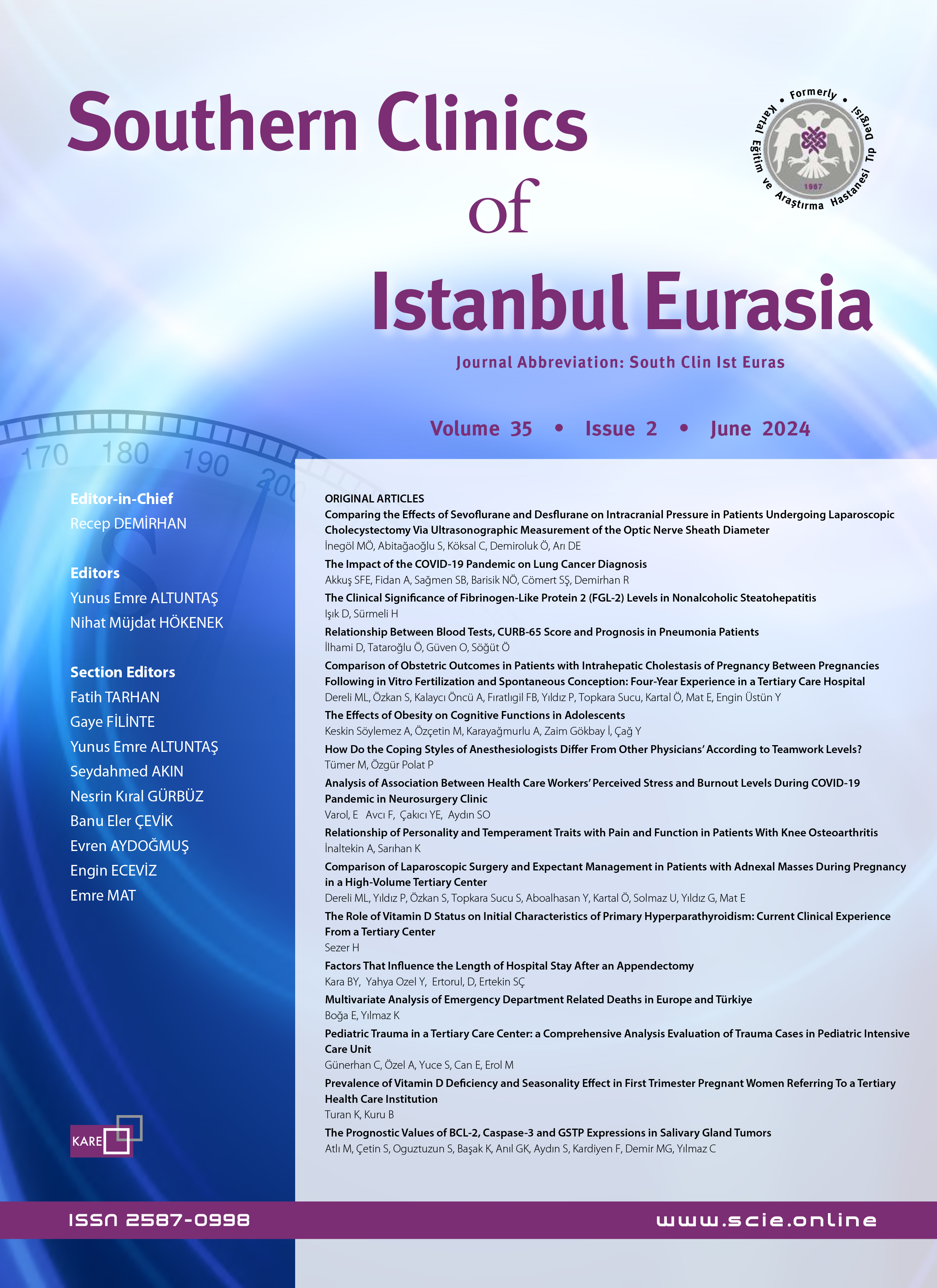Volume: 19 Issue: 1 - 2008
| RESEARCH ARTICLE | |
| 1. | Evaluation of our results with proximal femoral nail and sliding hip screw methods in the management of geriatric intertrochanteric hip fractures Ufuk Özkaya, Murat Gül, Atilla Sancar Parmaksızoğlu, Seçkin Basılgan, Yavuz Kabukçuoğlu Pages 1 - 6 OBJECTIVE: The results of two different methods used in our clinic in the treatment of proximal femoral geriatric fractures were compared and prognostic factors were determined. METHODS: During 2001-2006, patients over 70 years old treated with either dynamic hip screw (Group I, n=46; 18 males, 28 females; mean age 80.1; range 70 to 95 years) or proximal femoral nail (Group II, n=33; 12 males, 21 females; mean age 78.8; range 70 to 92 years) for pertrochanteric fractures were retrospectively evaluated. AO/OTA classification system was used. RESULTS: The mean follow-up period was 43.5 months (14-71) for Group I and 23 months (18-31) for Group II. Reoperation was necessary in 3 (6.5%) patients in Group I and in 2 (6%) patients in Group II. Mortality rate in the first postoperative year was 13% (n=6) in Group I and 6% (n=2) in Group II. Parker-Palmer mobility scores in Group I and in Group II at the last assessment were 5 (3-9) and 6.5 (4-9), respectively. No statistical difference was noted between the two treatment methods with respect to Singh index scores, collodiaphyseal angles and tip-apex measurements with the Mann-Whitney U test. Retroscopic evaluation of the poor results of both methods proved that unsatisfactory surgical technique resulted in implant failures. CONCLUSION: Our conclusion is that the question to be asked is not which implant?, but how good is the surgical technique?. |
| 2. | Comparison of the effect of levobupivacain and bupivacain during epidural anesthesia in elective hysterectomies Feriha Temizel, Özlem Demirtaş, Tamer Kuzucuoğlu, Gülten Arslan, Hakan Erkal, Hüsnü Süslü, Yaman Özyurt, Göksu Yurtcan Pages 7 - 16 OBJECTIVE: We aimed to compare the effects of bupivacaine and levobupivacaine applied by an epidural catheter in elective hysterectomies. METHODS: Fifty patients, ASA I-II class, were included in this study. Patients were divided into two groups randomly as bupivacaine (Group B) or levobupivacaine (Group L). Group B received 17 ml (85 mg) bupivacaine and Group L received 17 ml (85 mg) levobupivacaine. Hemodynamic parameters were recorded before achievement of epidural block, at the beginning of block and at the 5th, 10th, 15th, 30th, 45th, 60th, 90th, and 120th minute, at the end of the operation, and at the postoperative 15th and 30th minute. Sensorial level was evaluated by loss of sensation to both cold (ice test) and pinprick test and motor block intensity was assessed bilaterally with modified Bromage scale every two minutes. The onset of sensorial block and motor blockade, time to reach T6 sensorial blockade, time to regression of motor and sensorial block, duration of postoperative first analgesic requirement, side effects, and operation time were recorded. The visual analog scale (VAS) was used to assess the intensity of pain during surgery. RESULTS: There were no statistically significant differences between the two groups according to the demographic-hemodynamic data and ASA physical status (p>0.05). There was also no statistically significant difference between the two groups according to the onset of and time to regression of sensory and motor blocks, duration of the postoperative first analgesic requirement and duration of the surgery (p>0.05). CONCLUSION: In view of the determined similarities, we concluded that levobupivacaine seems to be a suitable alternative to bupivacaine in epidural anesthesia. |
| 3. | The occurrence rate of possible etiological factors in urticaria Yıldız Mayadağlı, Demet Duman, Nesrin Özbaş, Havva Kahraman Pages 17 - 22 OBJECTIVE: The aim of this study was to determine the occurrence rate of factors that possibly cause urticaria in order to appropriately inform patients. METHODS: Sixty patients who were referred to the Dermatology Department of Cerrahpasa Faculty of Medicine between October 2007 and March 2008 were enrolled in the study. Data were obtained by a questionnaire containing 22 items regarding age, sex, duration of illness, and food or other factors that might have caused urticaria and the 21-item Beck depression scale. Statistically, data were evaluated using the standard SPSS for Windows 16.0 program and chi-square test. RESULTS: Seventy-five percent of the cases were female; 55% had urticaria for less than 6 weeks and 45% for more than 6 weeks. Etiological factors included consumption of cheese in 50% of patients, chocolate and fruit in 46.7%, and pickles in 45% in the last 24 hours before the attack. Thirty-three percent of patients had taken some sort of medication before the attack. An infectious focus was discovered by the physician in 21.7% of all patients. CONCLUSION: The Beck depression scale revealed depression in all patients. While searching for an etiological factor for urticaria, the patients emotional status should also be considered. |
| 4. | Micrometastases screening in lymph node-negative breast carcinomas and comparison with prognostic parameters Aylin Dengizmen, Ayşenur Akyıldız İğdem, Elife Şahan, Nusret Erdoğan Pages 23 - 29 OBJECTIVE: The status of axillary lymph nodes has prognostic significance in breast cancer. In fact, patients diagnosed as axillary lymph node-negative by standard histopathological methods may have micrometastases. To date, 9-33% of cases were determined as having micrometastases in many studies using variable methods. In this study, axillary lymph nodes were investigated by increasing the sections and with immunohistochemical staining. METHODS: Thirty-one patients with invasive breast cancer but without axillary lymph node metastases were included in this study. One hundred and thirteen paraffin blocks of 458 lymph nodes were sectioned at 300 micrometer intervals. Every section was stained with hematoxylin and eosin (H&E) and immunohistochemically by AE1-AE3 antibody. RESULTS: Micrometastases were discovered in 6 (19.3%) of the 31 patients. Three of the discovered micrometastases were 0.2-2 mm in diameter and the other three were distributed as isolated tumor cells. There was an advanced meaningful association between lymphovascular invasion and micrometastases. CONCLUSION: In patients with breast cancer who were evaluated by standard histopathological methods and were lymph node-negative, the possibility of discovering metastases may increase by increasing the lymph node sections and with H&E and immunohistochemical staining. Lymph node micrometastases can not be determined by standard histopathological methods. |
| 5. | The classification of hypertension in females according to the age groups, evaluation of their lipid panels and comparison with geriatric cases Bülent Turhan, Burcu Tümerdem Çalık, İbrahim Etli, Orhan Akpınar Pages 30 - 35 OBJECTIVE: The aims of this study were to classify hypertension according to age groups, to determine the relation between their lipid panels and to compare results with the geriatric cases. METHODS: A cross-sectional study of 1100 hypertensive females registered at the biochemistry laboratory in 2008 was done. Cases with triglyceride ≥400 mg/dl, prescribed repetitions and other applications were excluded. Cases (n: 198) were evaluated according ESH/ESC 2007 and NCEP ATPIII guidelines. Mean, SD, Student-t, chi-square, one-way ANOVA and Fishers exact tests were applied. Results were evaluated in 95% confidence interval, and significance was set at p<0.05. RESULTS: The mean age of cases was 62.44±12.27 and mean blood pressure was 164.9±26.1 / 94.5±15.1 mmHg. Twenty-six cases (13.13%) were 40-50 years and 56 cases (28.28%) were 51-60 years. Cases 40-50 years were found to have grade 1 hypertension, and >51 years were found to have grade 2 hypertension. Although dyslipidemia was present in all age groups, no significant differences were found between triglyceride, cholesterol, and high- and low-density lipoprotein cholesterol (HDL-C, LDL-C) levels (p>0.05). While there was no significant difference between blood pressure, cholesterol, HDL-C and LDL-C levels in geriatric cases and cases <65 years (p>0.05), triglyceride levels were significantly lower in geriatric patients (p<0.01). CONCLUSION: Presence of hypertension and high rate of dyslipidemia in spite of medication shows the importance of individual cardiovascular risk assessment. Menopausal changes should not be ignored. |
| CASE REPORT | |
| 6. | Anesthesia management of a patient with laringeal tumor with expected difficult intubation: Case report Gülten Arslan, Kemal Tural, Halil İbrahim Güngör, Feriha Temizel, Yaman Özyurt, Zuhal Arıkan Pages 36 - 39 Tracheal intubation using direct laryngoscopy has become an essential part in the anesthesia management of the surgical patient. In the majority of cases, the larynx and glottis are easily visualized by direct laryngoscopy; however, in a few cases, the anesthesiologist unexpectedly faces difficult intubation. Difficult or failed intubation is a common cause of mortality and morbidity related to anesthesia. We report a case of difficult airway in a 56-year-old man with a laryngeal mass during induction of general anesthesia. |
| 7. | Cyst of tunica albuginea: A case report Metin İshak Öztürk, Orhan Koca, Abdullah İlktaç Pages 40 - 43 Testicular and extratesticular masses can be determined in the scrotal sac. Although cysts of the tunica albuginea are usually incidental findings, patients may present with pain, swelling and firm pinhead-sized mass. These cysts are thought to be of mesothelial origin. We report a case of a 57-year-old man who presented with left scrotal mass. |
| 8. | Anesthetic management of a patient with Mobius syndrome Tamer Kuzucuoğlu, Feriha Temizel, Hatice Yılmaz, Aygün Altınel, Ayşegül Arayıcı, Betül Ayaz Pages 44 - 47 We report the case of a two-year-old female with Mobius syndrome, ASA-I, weighing 12.5 k. Examination revealed congenital bilateral sixth nerve and left seventh nerve palsy. There was no papilledema, tumor, or intracranial pressure increase on MRI analysis. In oral examination, Mallampati III was recorded. Operation was planned under general anesthesia. No premedication was administered and anesthesia was achieved with sevorane 8% in three sequences under deep breathing. Vecuronium bromide (0.1 mg/kg) was used for neuromuscular block and fentanyl 1 mcg/kg was used for analgesic medication. After two failed attempts, intubation was successful on the third trial by the same doctor. Anesthesia was maintained with 40/60% oxygen-N2O using sevorane 2%. Cardiac and respiratory parameters stabilized during the operation. The patient was extubated in good condition, and transported to the recovery room. After cardiac and hemodynamic parameters had stabilized, the patient was transported to the relation clinic. In conclusion, it should be remembered that Mobius syndrome destroys multiple systems in the body and results in difficult intubation due to orofacial anomaly. |
| REVIEW | |
| 9. | Classification of diabetic neuroptahy and clinical manifestations Recep Alp Pages 48 - 56 Abstract | |



















